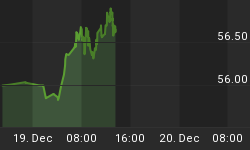Below is an extract from a commentary originally posted at www.speculative-investor.com on 15th June 2006.
When the yield-spread is widening, that is, when short-term interest rates are falling relative to long-term interest rates, it typically means one or more of the following:
1. The Fed is aggressively pushing short-term interest rates lower in response to economic weakness or the market is anticipating aggressive monetary easing by the Fed in response to a weakening economy. This was the situation between the final quarter of 2000 and the third quarter of 2003.
2. Short-term interest rates are rising, but long-term interest rates are rising at a faster pace because the market fears that the Fed is not doing enough to quell a growing inflation problem. This was the situation during much of the 1970s.
A substantial widening of the yield-spread will often be accompanied by widening credit spreads, contracting financial liquidity and a general increase in risk aversion.
On the other hand, when the yield-spread is falling, that is, when short-term interest rates are rising relative to long-term interest rates, it typically means that: a) the Fed is hiking short-term interest rates at a fast enough pace to maintain downward pressure on inflation expectations, and/or b) there is strong/rising demand for short-term money in order finance various speculations. Both a) and b) describe the situation over the past 2.5 years.
A substantial contraction of the yield-spread will often be accompanied by falling credit spreads and expanding financial liquidity as investors/speculators take-on more risk in an attempt to maximise their returns.
Those who understand the monetary nature of gold will realise that the sort of financial backdrop normally associated with a widening yield-spread is conducive to strength in the gold price whereas the sort of financial backdrop normally associated with a contracting yield-spread is not one in which gold is likely to do well. However, gold did extremely well during the 12-month period ended 11th May of this year while the yield-spread contracted in relentless fashion. It seems, therefore, that gold was somehow able to ignore an unfavourable interest rate backdrop during this period.
The apparent inconsistency in gold's performance can be explained. The interest rate backdrop might have been downright unfriendly for gold between May of 2005 and May of 2006, but in this particular case the deluge of liquidity created by the actions of foreign (non-US) central banks and hedge funds swamped all other forces and enabled the gold price to rally in terms of the fiat currencies. However, the adverse effect on gold of the contracting yield-spread can be seen by looking at how the monetary metal performed relative to other metals. As illustrated by the following chart, gold has been trending lower relative to the GYX (the Industrial Metals Index) since the Q3-2003 peak in the yield-spread and effectively crashed relative to the GYX between October of last year and early May of this year.

We'll now take a quick detour and look at a chart showing how the gold/GYX ratio (gold versus a basket off industrial metals) performed relative to the broad US stock market over the past 6 years. A strong inverse correlation between gold/GYX and the S&P500 Index is obvious on the following chart. Clearly, gold has done relatively well when the broad stock market has been trending lower and relatively poorly when the broad stock market has been trending higher. This is exactly what we'd expect from the monetary metal.

Now, some of our current expectations are:
1. The broad stock market is about two months into a downturn that will last 6-12 months.
2. The US economy is slowing and will likely shift into reverse later this year in response to the cyclical bear market in real estate and a general contraction in liquidity.
3. As a result of 1) and 2) above, the Fed will soon end its rate-hiking campaign and will be cutting rates by the final quarter of this year.
4. As a result of 1), 2) and 3) above, the yield-spread will soon experience a major upward trend reversal.
That is, we are expecting the financial backdrop to soon become very favourable for gold, leading to a period in which gold makes substantial gains relative to all other metals as well as fiat currencies. Therefore, although the initial setbacks in global equity markets and the industrial metals have predictably been accompanied by a sharp decline in the gold price, it is important to keep in mind that what's happening now is setting the stage for gold to rally against almost everything.















